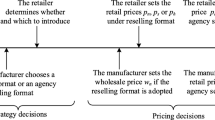Abstract
Store brands are the only brands for which the retailer is responsible not onlyfor promotion, shelf placement, and pricing, but also for positioning the brandin product space. We argue that retailers strongly value control over store brandpositioning because they will be unable to source a national brand with theirdesired product positioning. This is because retailers have an incentive to positionstore brands as close substitutes to leading national brands – a location in productspace which other national brand manufacturers would not find profitable. We presentempirical evidence that is consistent with the results of our model.
Similar content being viewed by others
References
Aaker, D. A. (1991) Managing Brand Equity. New York: The Free Press.
Ailawadi, K., and B. Harlam (2004) ‘An Empirical Analysis of Retail Margins: The Role of Store Brand Share’, Journal of Marketing, forthcoming.
Berto Villas-Boas, S. (2003) ‘Vertical Relationships between Manufacturers and Retailers: An Empirical Analysis’.
Brandenburger, A. M., and B. J. Nalebuff (1996) Co-opetition.New York, NY: Doubleday.
Corstjens, M., and R. Lal (2000) ‘Building Store Loyalty through Store Brands’, Journal of Marketing Research 37(2).
Cotterill, R., R. Dhar, and W. Putsis (1997) ‘On the Competitive Interaction between Private-Label and Branded Grocery Products’.
Cremer, J., and M. H. Riordan (1987) ‘On Governing Multilateral Transactions with Bilateral Contracts’, Rand Journal of Economics 18(3), 436–451.
Dhar, S. K., and S. J. Hoch (1997) ‘Why Store Brand Penetration Varies by Retailer’, Marketing Science 16(3), 208–227.
Dunne, D., and C. Narasimhan (1999) ‘The New Appeal of Private Labels’, Harvard Business Review 77(3).
Giblen, G. (1993) ‘Summit Conference Defines Future’, Grocery Marketing 53, 32–37.
Hoch, S. J., and S. Banerji (1993) ‘When Do Private Labels Succeed?’, Sloan Management Review 34(4), 57–67. Access restricted.
Keller, K. L. (1998) Strategic Brand Management. Upper Saddle River, NJ: Prentice Hall.
McAfee, R. P., and M. Schwartz (1994) ‘Opportunism in Multilateral Vertical Contracting: Nondiscrimination, Exclusivity, and Uniformity’, American Economic Review 84(1), 210–230.
Mills, D. E. (1995) ‘Why Retailers Sell Private Labels’, Journal of Economics and Management Strategy 4(3), 509–528.
Narasimhan, C., and R. T. Wilcox (1998) ‘Private Labels and the Channel Relationship: A Cross-Category Analysis’, Journal of Business 71(4), 573–600.
O'Brien, D. P., and G. Shaffer (1992) ‘Vertical Control with Bilateral Contracts’, Rand Journal of Economics 23(3), 299–308.
O'Brien, D. P., and G. Shaffer (1997) ‘Nonlinear Supply Contracts, Exclusive Dealing, and Equilibrium Market Foreclosure’, Journal of Economics and Management Strategy 6, 755–785.
Raju, J. S., R. Sethuraman, and S. K. Dhar (1995) ‘The Introduction and Performance of Store Brands’, Management Science 41(6), 957–978.
Rey, P., and T. Verge (2002) ‘Resale Price Maintenance and Horizontal Cartel’.
Sayman, S., S. J. Hoch, and J. S. Raju (2002) ‘Positioning of Store Brands’, Marketing Science 21(4), 378–397.
Shaffer, G. (2002) ‘Bargaining in Distribution Channels with Multi-Product Retailers’.
Shaffer, G. E., and F. Zettelmeyer (2002) ‘When Good News about your Rival is Good for You: The Effect of Third-Party Information on the Division of Channel Profits’, Marketing Science 21(3), 273–93.
Shaffer, G. E., and F. Zettelmeyer (2004) ‘Advertising in a Distribution Channel’, Marketing Science, forthcoming.
Steenkamp, J.-B. E. M., and M. G. Dekimpe (1997) ‘The Increasing Power of Store Brands: Building Loyalty and Market Share’, Long Range Planning 30(6), 917–930.
Sutton, J. (1991) Sunk Costs and Market Structure: Price Competition, Advertising, and the Evolution of Concentration. Cambridge, MA: MIT Press.
Author information
Authors and Affiliations
Rights and permissions
About this article
Cite this article
Scott Morton, F., Zettelmeyer, F. The Strategic Positioning of Store Brands in Retailer–Manufacturer Negotiations. Review of Industrial Organization 24, 161–194 (2004). https://doi.org/10.1023/B:REIO.0000033350.25229.d6
Issue Date:
DOI: https://doi.org/10.1023/B:REIO.0000033350.25229.d6




